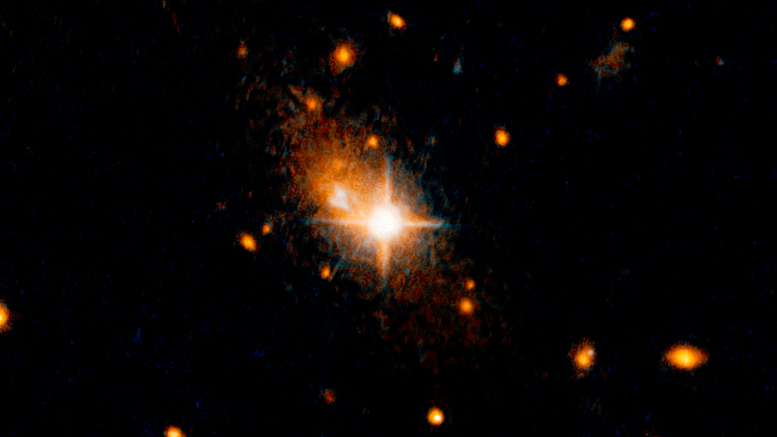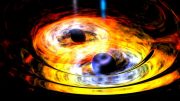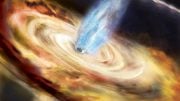
The galaxy 3C186, located about 8 billion years from Earth, is most likely the result of a merger of two galaxies. This is supported by arc-shaped tidal tails, usually produced by a gravitational tug between two colliding galaxies, identified by the scientists. The merger of the galaxies also led to a merger of the two supermassive black holes in their centers, and the resultant black hole was then kicked out of its parent galaxy by the gravitational waves created by the merger. The bright, star-like looking quasar can be seen in the center of the image. Its former host galaxy is the faint, extended object behind it.
Using the Hubble Space Telescope, astronomers reveal a supermassive black hole that has been propelled out of the center of the distant galaxy 3C186. The black hole was most likely ejected by the power of gravitational waves. This is the first time that astronomers found a supermassive black hole at such a large distance from its host galaxy center.
Though several other suspected runaway black holes have been seen elsewhere, none has so far been confirmed. Now astronomers using the NASA/ESA Hubble Space Telescope have detected a supermassive black hole, with a mass of one billion times the Sun’s, being kicked out of its parent galaxy. “We estimate that it took the equivalent energy of 100 million supernovae exploding simultaneously to jettison the black hole,” describes Stefano Bianchi, co-author of the study, from the Roma Tre University, Italy.
The images taken by Hubble provided the first clue that the galaxy, named 3C186, was unusual. The images of the galaxy, located 8 billion light-years away, revealed a bright quasar, the energetic signature of an active black hole, located far from the galactic core. “Black holes reside in the centers of galaxies, so it’s unusual to see a quasar not in the center,” recalls team leader Marco Chiaberge, ESA-AURA researcher at the Space Telescope Science Institute, USA.

This illustration shows how two supermassive black holes merged to form a single black hole which was then ejected from its parent galaxy. Panel 1: Two galaxies are interacting and finally merging with each other. The supermassive black holes in their centers are attracted to each other. Panel 2: As soon as the supermassive black holes get close they start orbiting each other, in the process creating strong gravitational waves. Panel 3: As they radiate away gravitational energy the black holes move closer to each other over time and finally merge. Panel 4: If the two black holes do not have the same mass and rotation rate, they emit gravitational waves more strongly along one direction. When the two black holes finally collide, they stop producing gravitational waves and the newly merged black hole then recoils in the opposite direction to the strongest gravitational waves and is shot out of its parent galaxy.
The team calculated that the black hole has already traveled about 35,000 light-years from the center, which is more than the distance between the Sun and the center of the Milky Way. And it continues its flight at a speed of 7.5 million kilometers per hour. At this speed, the black hole could travel from Earth to the Moon in three minutes.
Although other scenarios to explain the observations cannot be excluded, the most plausible source of the propulsive energy is that this supermassive black hole was given a kick by gravitational waves unleashed by the merger of two massive black holes at the center of its host galaxy. This theory is supported by arc-shaped tidal tails identified by the scientists, produced by a gravitational tug between two colliding galaxies.
According to the theory presented by the scientists, 1-2 billion years ago two galaxies — each with central, massive black holes — merged. The black holes whirled around each other at the center of the newly-formed elliptical galaxy, creating gravitational waves that were flung out like water from a lawn sprinkler. As the two black holes did not have the same mass and rotation rate, they emitted gravitational waves more strongly along one direction. When the two black holes finally merged, the anisotropic emission of gravitational waves generated a kick that shot the resulting black hole out of the galactic center.
“If our theory is correct, the observations provide strong evidence that supermassive black holes can actually merge,” explains Stefano Bianchi on the importance of the discovery. “There is already evidence of black hole collisions for stellar-mass black holes, but the process regulating supermassive black holes is more complex and not yet completely understood.”
The researchers are lucky to have caught this unique event because not every black hole merger produces imbalanced gravitational waves that propel a black hole out of the galaxy. The team now wants to secure further observation time with Hubble, in combination with the Atacama Large Millimeter/submillimeter Array (ALMA) and other facilities, to more accurately measure the speed of the black hole and its surrounding gas disc, which may yield further insights into the nature of this rare object.
Reference: “The puzzling case of the radio-loud QSO 3C 186: a gravitational wave recoiling black hole in a young radio source?” by M. Chiaberge, J. C. Ely, E. T. Meyer, M. Georganopoulos, A. Marinucci, S. Bianchi, G. R. Tremblay, B. Hilbert, J. P. Kotyla, A. Capetti, S. A. Baum, F. D. Macchetto, G. Miley, C. P. O’Dea, E. S. Perlman, W. B. Sparks and C. Norman, 30 March 2017, Astronomy & Astrophysics.
DOI: 10.1051/0004-6361/201629522
arXiv









Be the first to comment on "Hubble Reveals a Supermassive Black Hole Kicked Out of Galactic Core"